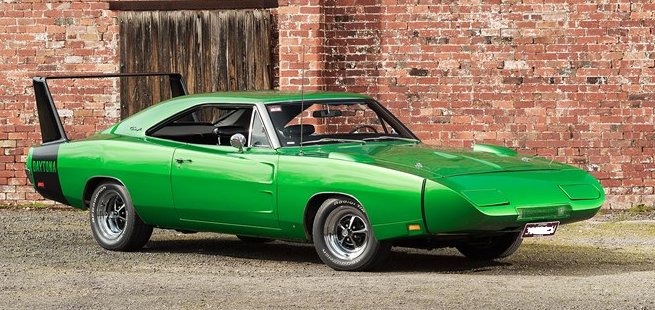
 |
| Return | Next Favorite |
|---|
| As it turns out, Dodge was having some trouble in the air handling department on the Super Speedways of NASCAR. It seems that at high speeds, Chargers couldn't decide if they wanted to be cars or airplanes and nobody wanted their mid-sized Hot Rod trying to leave the ground at 180 miles an hour. The real bottom line, they were having trouble winning on Sunday and they needed an edge. The redesigned back window and front end changes that created the new Charger 500, made some improvements but they needed more. Enter the Charger Daytona. The Daytona started life as a garden variety Charger R/T with it's base engine, the 440 Magnum rated at 375 horsepower at 4600 RPM and 480 ft/lbs. of torque at 3200 or the optional 426 Hemi rated 425 horsepower at 5000 RPM and 490 ft/lbs. at 4000. They were then sent Creative Industries, a company in Detroit that did car modifications, where they received the 18 inch long bullet shaped nose with a small air dam underneath, the rear window "plug", and a rear wing that was made of aircraft grade aluminum. The front fenders received rear facing scoops with screen covered holes underneath that would create a vacuum at high speeds to draw air out of the wheels houses and combat air lift. The trunk lid was shortened to clear the window plug which made everything flow together for a great look but access to the trunk was a slightly limited. Not only was this the most outrageous looking musclecar to come out of Detroit "Rock City", it was also the best air handler. In it's debut at the Talladega 500, Charlie Glotzbach qualified on the pole with a record setting 199.466 miles an hour! Now these were not tube chassis, template fitting, cookie cutter stock cars like we have today, this was the same body that you could buy at your local Dodge dealer. Dodge had suceeded in creating the fastest stock car ever! The reason that it was the same body that you could buy from your Dodge dealer was because, per NASCAR rules, there had to be 500 consumer versions of the car to make it legal for NASCAR racing. So, because of that, 503 Daytonas were built with a base price $3993, only about $350 more than the Charger R/T. The base engine was, of course, the 440 Magnum with the 426 Hemi as a $648 option. A 4-speed transmission was standard as was a 3.55 rearend gear and 727 TorqueFlite automatic was the transmission option. Though the 440 Six Pack was not on the available options list, two Daytonas are known to have received the three-two barrel set up as a dealership installation. All in all, love it or hate it, the Dodge Charger Daytona was proof positive that car manufacturers were in serious competition on the street, track and market place. For a car that was only sold in the latter half of the 1969 model year and only produced a little over 500 copies, the Charger Daytona has made a statement that has stood the test of time. Dodge still uses the Dayton name, playing on the memories of the original model to make sales, and there's even a Daytona nose and wing package for the new Retro Challengers. With the turn that racing has taken, it's quite possible that there will never be another opportunity for a car to change the game the way that MOPAR's winged warriors did, but during a time when it was possible to do it, the Daytona did it... with style.  - Dan Davis. |